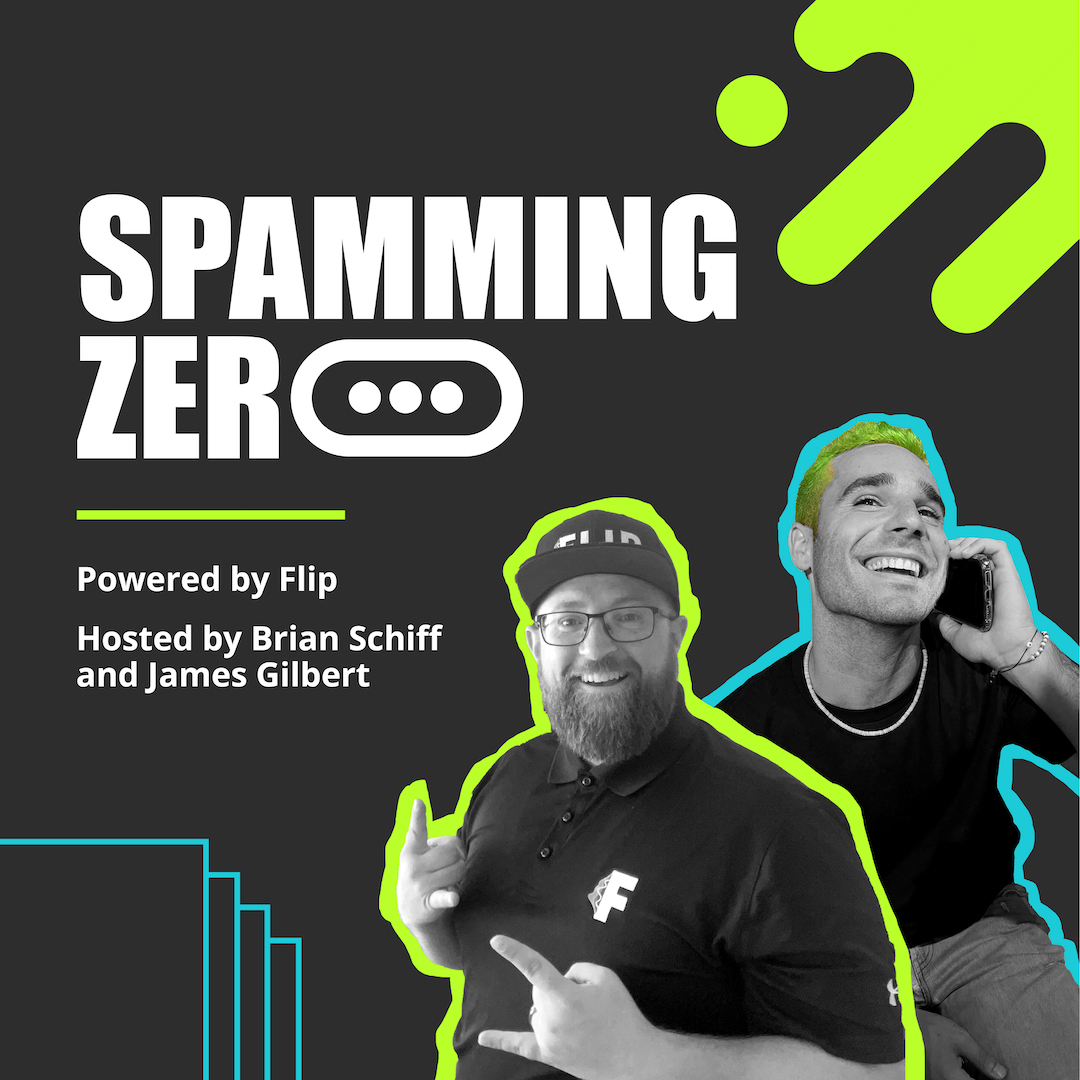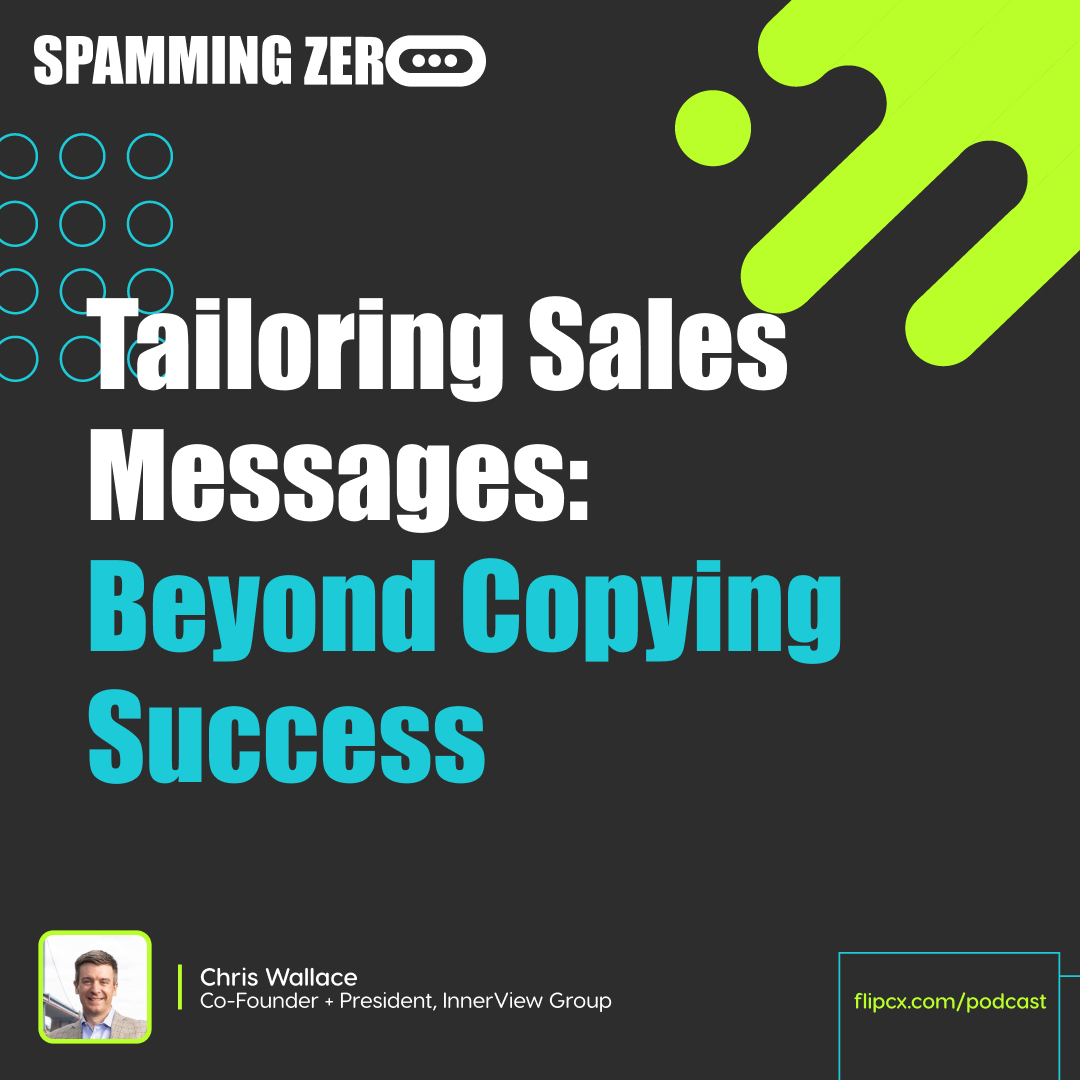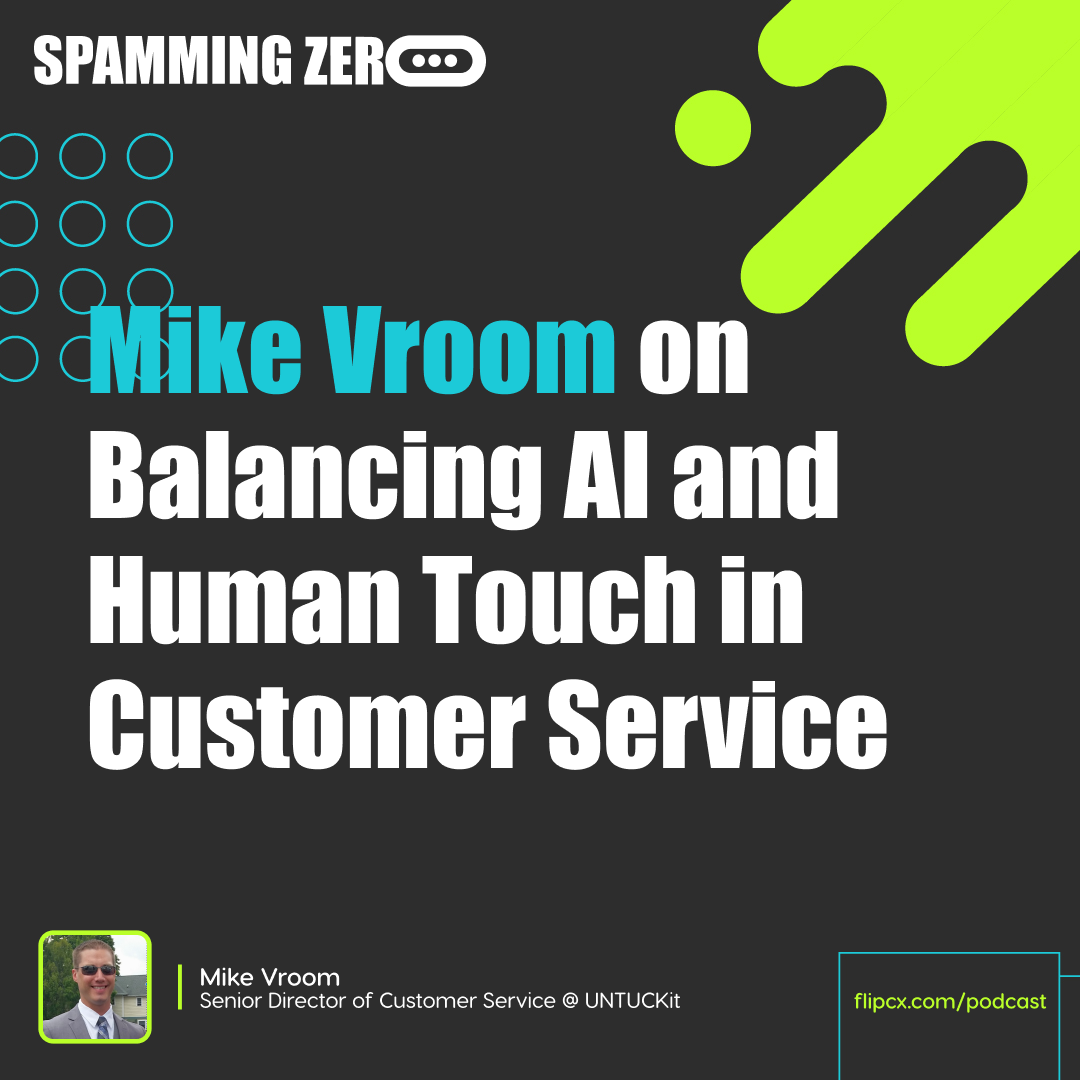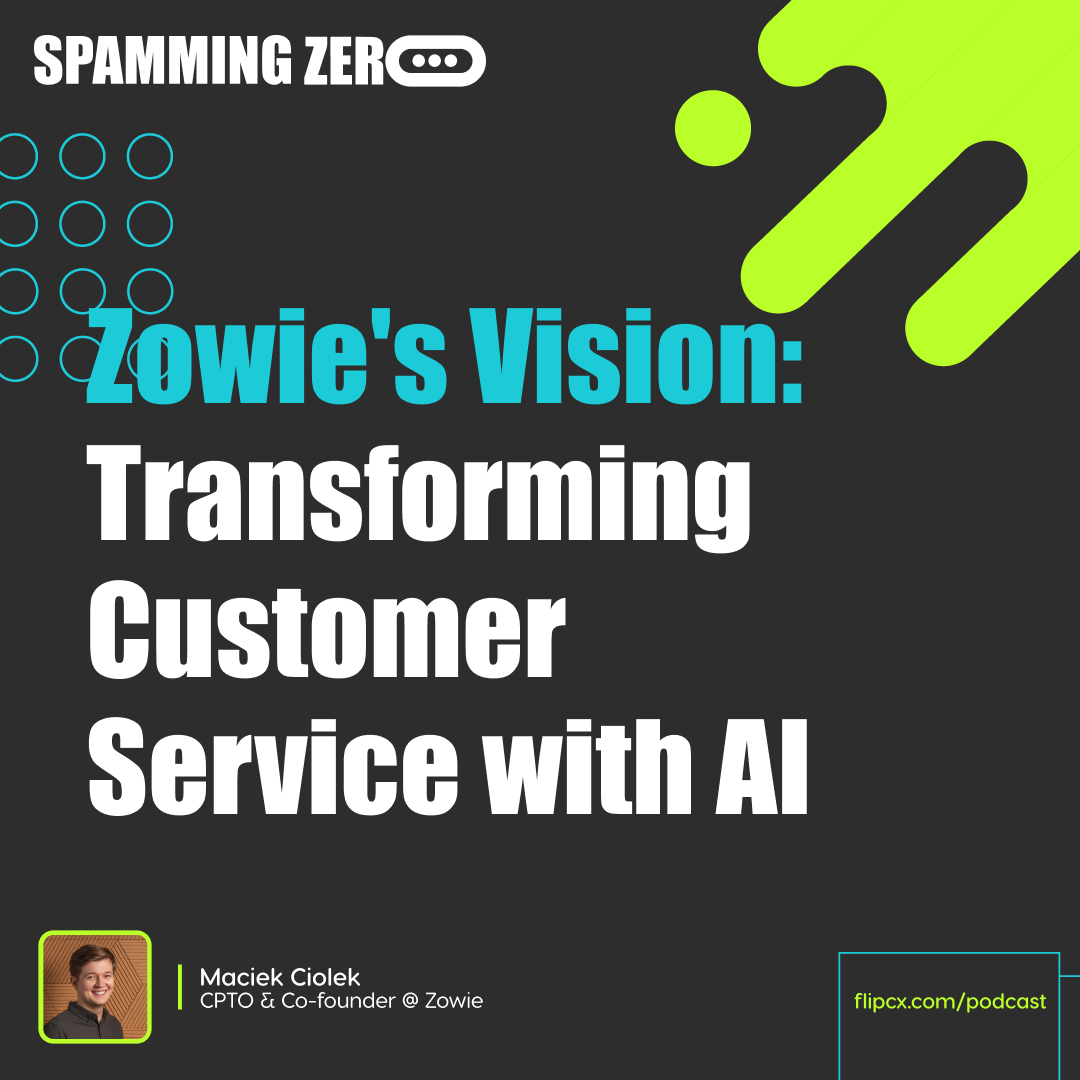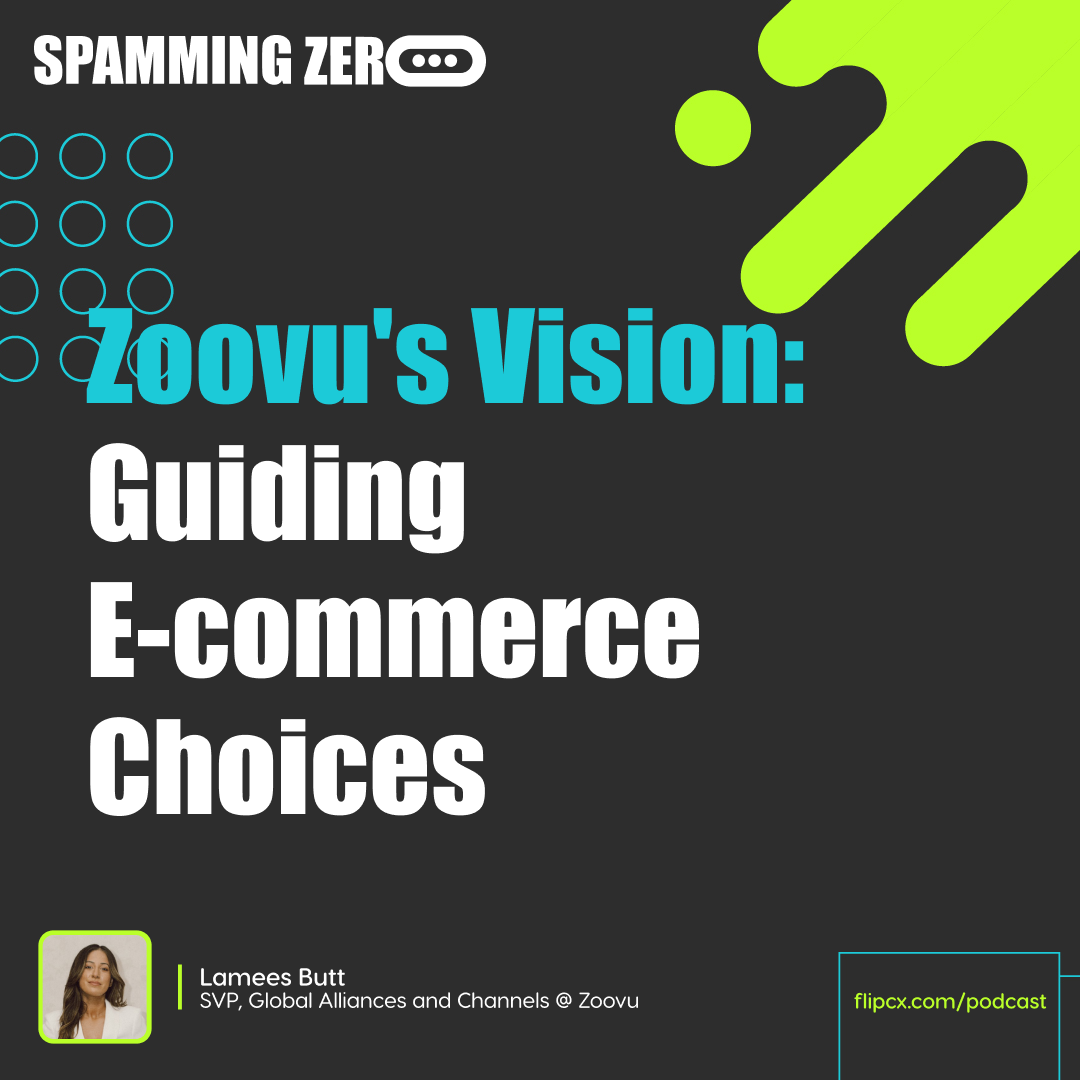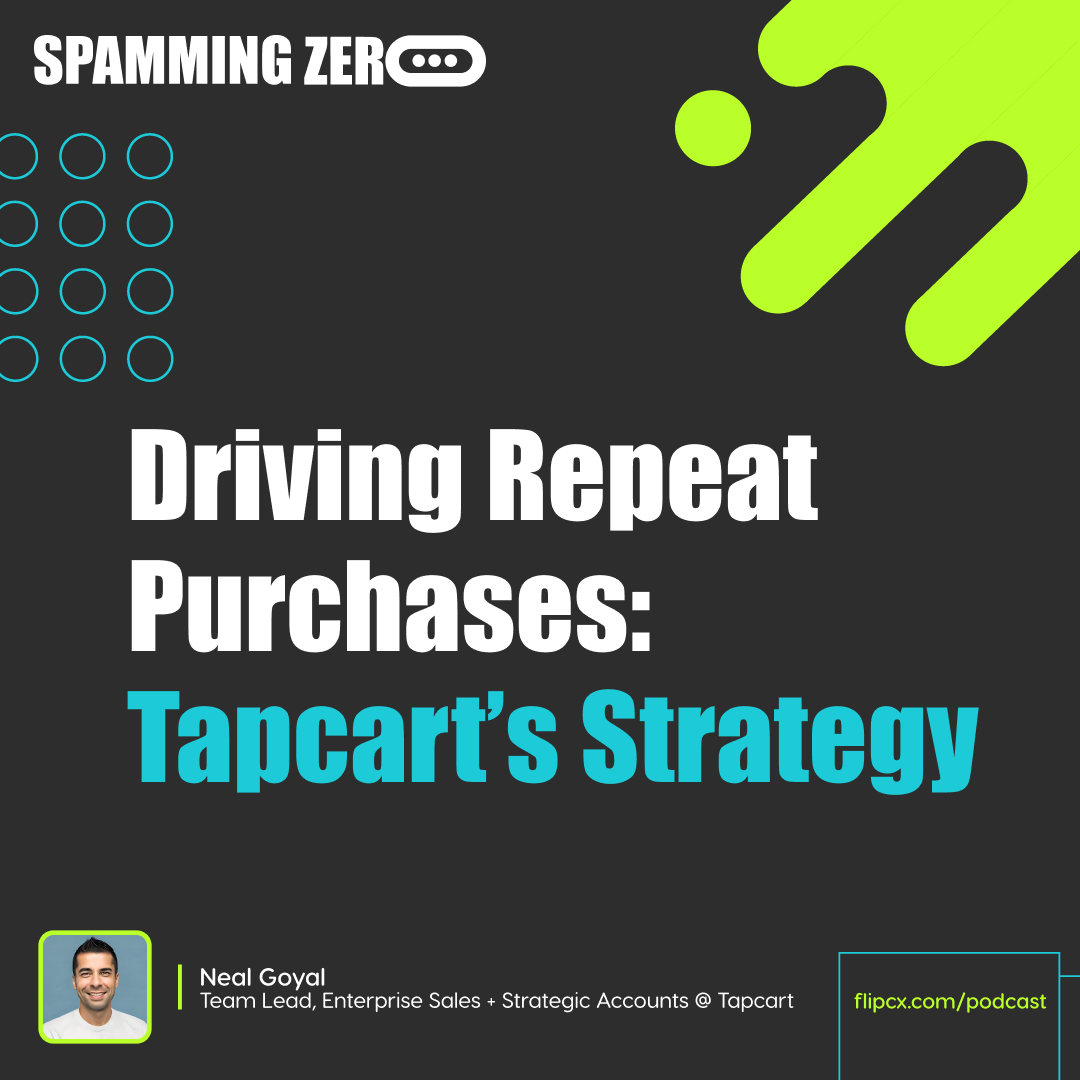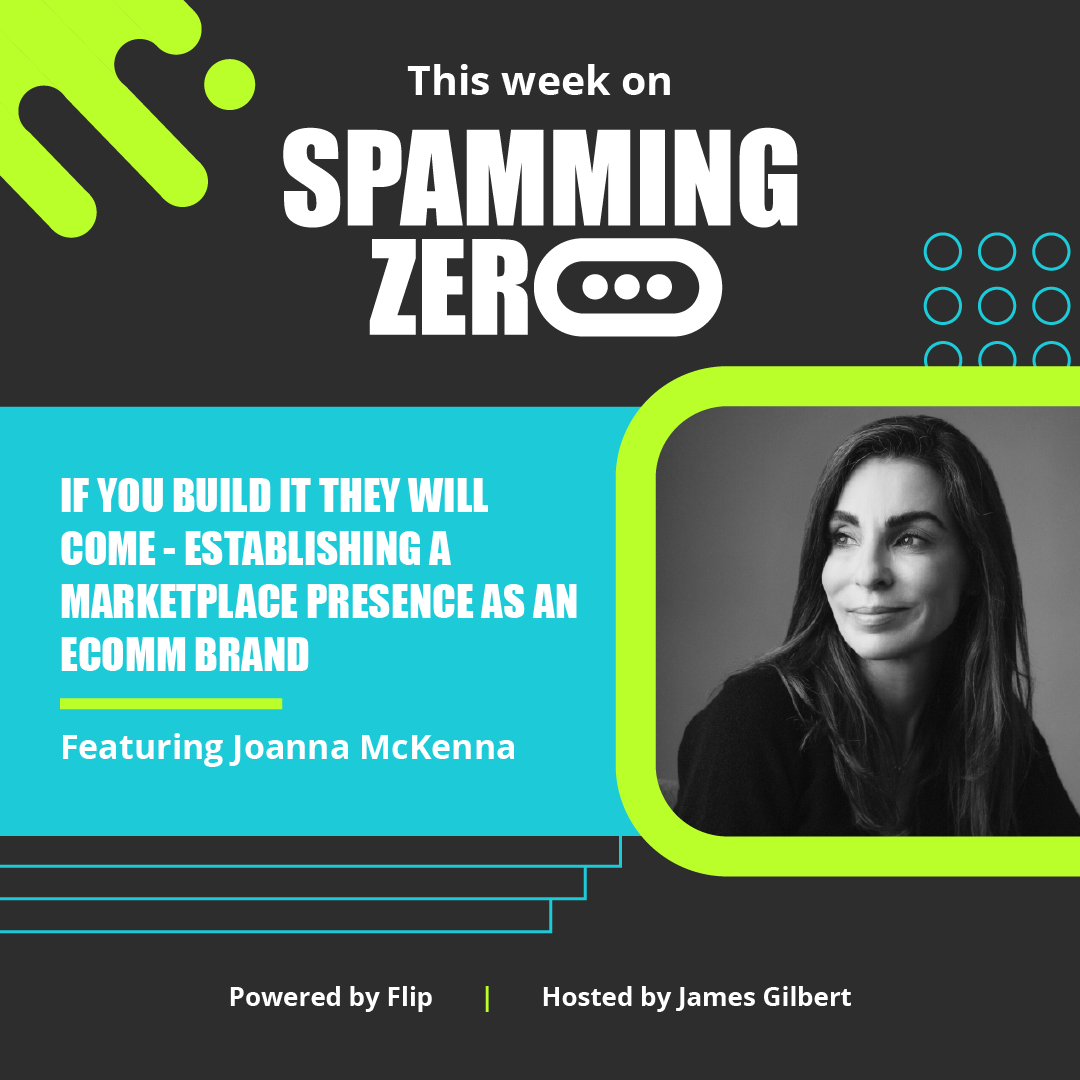Episode 64: Tailoring Sales Messages - Beyond Copying Success, With Chris Wallace
- 0.5
- 1
- 1.25
- 1.5
- 1.75
- 2
Chris Wallace: You can't just get somebody to know, you have to get them to believe in it. And sometimes you just need reps to believe in it. So, I think one of the areas where companies get it wrong is they think messaging means, " Let's go find out the words that work from the people who have the best sales results." But the reality is you wouldn't clone that. And frankly, a lot of times they're not on message. You don't want everybody doing it the way that they are.
James Gilbert: I'm James.
Brian: And I'm Brian.
James Gilbert: And this is Spamming Zero. September 2023, Spamming Zero sponsor is Tapcart, tapcart. com. Listen to some of the brands that are using them today to make their mobile experience even better and to increase their revenue and potential with their customers, Princess Polly, True Classic Tees, Pier 1, Fashion Nova, White, Fox, Chubbies, Fanjoy. The list goes on and on, so many great customers. We all spend so much time on our mobile devices, so it's no question that you need to be thinking about a mobile first environment and digital experience, and Tapcart can provide that for you. Take a look at them, tapcart. com. Right now, they have a two- week trial that you can try out for free, and on top of that, they are backed by Shopify and many others, so you won't have to worry about that integration point. One of my favorite things about them on their website, on their homepage, if you go to their case studies, they have this little section called" Tailored for your mobile app for your industry." What's beautiful is they don't just look at e- commerce as a whole, they look at the specific niche industries because, let's be honest, if you're in beauty and cosmetics, you need a specific app for that. If you're in food and beverage, it's going to be unique. If you're in fashion and apparel, it's also going to be unique, if it's health and wellness, again, definitely unique. For out of the box options, for your specific industry, tapcart. com, go check them out. What's up everybody? I'm your host, James Gilbert on Spamming Zero. We are joined with Chris Wallace, who's the president of a company called InnerView, I- N- N- E- R- V- I- E- W. Go check them out. Chris, welcome to the show.
Chris Wallace: James, thanks so much for having me.
James Gilbert: So, Chris, you have this POV right now and it's a little bit of what interview does, but I want you to hit on it a little bit more, and this is primarily what we're going to be talking about on the podcast today, but it's this idea that you could find a lot of data and insights with your frontline employees and turning them into something that can actually help build the brand and grow. So, tell us a little bit about InnerView and where people can learn more about it?
Chris Wallace: Yeah, so, InnerView, backstory in InnerView is some partners of mine and I had run some professional services firms in the past, and we had the opportunity to restart, if you will, maybe reboot a little bit, and we drew on a lot of experience to decide what direction we wanted to go. And the thing that kept coming up, we went back, we looked at all of our old clients, all the work that we had done over the years, and we looked for the common threads amongst all those things. And the one thing that we kept finding was the companies we were working with were launching new stuff all the time, introducing new things, one after the other products, promotions, pricing changes. There was constant change coming from the product teams and the marketing team. And the people that we hold so near and dear to our hearts are the frontline teams, the people that have retail stores, the call centers, the sales reps. All those people who out there have to tell the story and deliver the message are getting inundated with all this stuff. And what we've done with interview is really help organizations think about the connection between what they're doing from a consumer strategy and go to market perspective and the realities of the folks in the trenches every single day. So, what we try to do is help the leaders in the ivory tower, if you will, gain an understanding of what's happening in the trenches and ultimately, give them a glimpse into if you looked at your frontline teams like they were a buyer, not just the messenger, but think about them as the buyer and whether or not they are seeing the same thing that you are seeing, that they would unlock all sorts of interesting insights into, " What is happening when these people stand in front of a customer?"
James Gilbert: Love it. So, I want the audience to get to know you just a little bit on a personal level. So, I'd like to ask you just this question... well, a couple of them, but one question is this, what do you find is the most unusual place you find inspiration when it comes to customer experience and just in general how a brand could address it?
Chris Wallace: Unusual place I find inspiration with customer experience. I think anybody that works in customer experience has to be very mindful of how they act as a consumer themselves. And I think I find inspiration through looking at my own behaviors as a consumer and thinking about how would I deal with me if I were in their shoes, how would I account for my perspective and not doing it in a snarky way or doing it in a... you're sizing people up all the time, but really trying to bring in the... In the real world, other consumers act like I'm going to act, how can customers account for this because I'm probably not the easiest customer. People are in customer experience, I don't think are easy customers. So, I think looking it through the lens of my own experiences and drawing inspiration from that on a day in, day out basis, it could be an airline, it could be a rental car company, it could be a contractor at my home, but trying to draw from the, " Okay, what's happening here? How should I react and how would I want them to react?"
James Gilbert: Now, a lot of brands that listen to this show or a lot of people that listen to this show work for an e- commerce company or direct consumer brand. So, talk to me a little bit about your experience in working with those type of brands, one with InnerView and just your experience, in general. And let's move into how messaging plays a role and where can you find the deepest insights, especially with agents and how can you weave that in?
Chris Wallace: So, our roots are with direct to consumer B2C companies, so we've done anything from the call center to e- com, call centers, and buy flows, and things like that where agents are in centers supporting the eCommerce play to door to door and really, all channels in between. But when it comes to messaging, I think maybe the best way to answer is to say where we see people getting it wrong or where we think some of the challenges are. A lot of times what organizations will do is they'll say, " Well, we get insights from our frontline." Okay, great, how do you get them? " We go to our top performers and we ask them what they say." And we're like, " Whoa, whoa, whoa, whoa, how your top performers are getting the job done?" Any good sales leader or definitely marketing leader is going to tell you, " I wouldn't clone my best salespeople and have everybody do it the same way." There are some people that just know how to get it done. The complexity of the way they manage their customer relationships is beyond what most reps are able to deliver. For some reps, you just need them to be on message, and you need them to buy into the story that's being delivered. You got to get them to adopt it. We talk about the difference between knowledge and belief. You can't just get somebody to know, you have to get them to believe in it. And sometimes you just need reps to believe in it. So, I think one of the areas where companies get it wrong is they think messaging means, " Let's go find out the words that work from the people who have the best sales results." But the reality is you wouldn't clone that and frankly, a lot of times they're not on message. You don't want everybody doing it the way that they are.
James Gilbert: I love that. So, let's talk a little bit about what are the challenges that then, businesses run into in order to address some of the messaging problems that they do have. You're talking about teaching them about knowledge and beliefs, so let's unpack that a little bit. You come in, your organization is consulting for them and you're helping them out. Don't give your secret sauce, by any means, but maybe give the playbook of how you would approach this.
Chris Wallace: So, I'm going to tell the story through the lens of a current prospective client of ours. They're a current client, but they have a new product coming up. We learned about it last week. And they had teased it out to us before, but we actually got to see it last week. And it was actually better than they told us it was going to be. We were actually very impressed. And we're not easy to impress. And there are so many layers to the story around this product. There are so many layers. If you were to put it in the hands of one rep, they may say, " Oh, I'm going to talk all about the visuals of it and how great it looks, and the styling of it." You give it to somebody else and they're going to say, " Well, I'm going to talk about the durability of it." You give it to somebody else. The good news for our client is it does all those things, and they're actually all a good story. And I can talk about how we do this, what we want to try to help them do is to take what they know about the consumer. They know things. And this is a really interesting point that your listeners, hopefully, will take something away from. If you know things about the consumer that your frontline teams don't, you need to tell them, you need to tell them. And we have data to back up, that companies that are sharing customer research and customer feedback with their teams, their frontline teams are 33% more likely to be confident in serving that customer. So, you're able to raise that confidence level by sharing that information. But in the case with this client, take what you know about the consumer, let's take what the message you want to reach them with and let's take the different components, and let's weave these together into a story that your team can tell. It's not features and benefits, it needs to be a story. If it's not a story with a couple of different layers to it, then they're just going to be feature benefit dumping, and they're not necessarily going to hit on the one that resonates with the customer, and they're not going to be consistent. You're going to have 50 different versions of the same message. So, what we are doing is we're starting out with, " Okay, what is it that you want to convey to the customer?" And then, again, not giving away the secret sauce, we have a research tool that assesses frontline attitudes toward whatever it is that you're selling. It could be your product. It could be your brand, your brand position. It could be the customer experience you deliver. But we have a way to assess the frontline perceptions of that, and we can come back to an organization and say, " This is what you want to deliver to your customer, and this is what your teams are hearing. You've got a gap." So, having that feedback loop built in with your frontline teams and just saying, " What you think matters. We want to know what you think, we're going to account for it so we can support you the best we possibly can." That would be a key recommendation we would make.
James Gilbert: So, what's your advice then, to people who have a hard time consolidating all of this data? Because that's a big challenge, people want to get or want to push this feedback even to their agents, or they want to get the feedback from the agents, but a lot of times it gets stuck in this realm of how do we collaborate on it together? How do we build a structure where the data can be captured in both sides and shared? What's your advice to people that genuinely run into that cap?
Chris Wallace: So, I had a call with a client last week where we did a readout of one of our in front studies. And one of our top recommendations was there are three or four nuggets from the study that we just got, things that your team told us that you need to turn around and share with them immediately. You need to turn around and say, " It doesn't have to be the whole thing." You're not going to ask your call center agents or your retail team to consume a data report, but you can send out a one sheet or a couple of different graphics or short videos that say, " We ask for your opinion on this product." " It's a very important product to our organization, an important product to our customers, and this is what we heard from you. Thank you for that feedback with that we're able to do X, Y, and Z." So, even just quickly, most organizations struggle. I think this gets to the heart of your question. Most organizations struggle to pick out the two or three things. They think it's got to be 15 different charts or it's got to be some a white paper. Grab people's attention with two or three different punchlines that people are going to say, " Yes, that resonates. I can get that." Make it so it's digestible for people. Organizations struggle to do that.
James Gilbert: I love that. It actually reminds me of a few different brands that I think are doing this really, really well right now. I think about Patagonia is one that comes to mind. And Patagonia led behind a really great story of sustainability and making sure that... I mean the CEO, for Pete's sakes, gave up all of his shares for that reason because he wanted to solve one of the world's problems of a sustainable environment, and people got behind that story. Now, they had the same problem, actually, almost to a T that you're talking about right now. And their products were durable. Their products were outdoorsy. And they were using that type of messaging, and really, they grew really fast. But really until they started telling the story about sustainable environments, it didn't catch. So, I think it's a great example of what you're talking about is Patagonia. I think of another one, man, I've mentioned them way too much on this podcast, but Liquid Death, I think of them.
Chris Wallace: I think it's a great example. It's not one that I've had typically come up, but I think that's a really good example. But I think what you've highlighted with both those two brands is the daring to be different. And I think that one of the things that... when we do our studies, it's really beneficial to share with a marketing leader, " Here is where your team thinks you are different." " Here's where they think you're different." " Here's where they think you potentially have something that's not..." A lot of times companies are focused on the table stakes. You're in the outdoor apparel business and it's, oh, well it's warm and it's durable, and it's fashionable. And it's like, if you're not all those things, guess what? You don't survive in that business. So, that's table thinks, " What is it that makes us unique and different? What's the hook that can really help us connect with our consumers in a more call it emotional way?" And I think that that daring to be different. We did a study readout one time, it's actually in the pharmaceutical space. And what we said was, " Your team does not believe that you have the best product on the market." The marketing leader said to us, he goes, " You know what, that's okay because they told me where they think we are different and that's where we need to be different. Being different is more important right now than anything else. We have to get people's attention." " We have to focus on the thing that makes us different. We're good. Our product is very good. But if we focus our energy on convincing them that we've got the highest quality product, when in fact it's played, the quality is plenty good enough, we can't tell a story, we can't win." Let's tell a story that makes us different and we'll stand out when we're talking to our customers. And I think that Liquid Death and Patagonia do a great job of that.
James Gilbert: Yeah, I love this. I think that there's naturally a want to tap into frontline agents, more and more. I think there's naturally a want to train the agents more and more. Why do you think so many brands are not doing it?
Chris Wallace: My business is going to be very successful if I can come up with the answer to that question. I think it's a couple of things. And when we talk about customer experience, I think when you start using that phrase, even though it's expensive to spend money on technology, I think that most companies believe that that's a place where they can at least show incremental improvement technology. They feel like they have some control over, whereas their people, they don't. They don't look at human support as a scalable means of improvement. They look at it as an unwinnable fight. And frankly, I don't think that that's true. I also think that some of it just comes down to the orientation. People will say it's a chicken or the egg conversation. " Well, we have high turnover, so investing in that is not sensible for us." " It's not economically viable for us." My answer to that is, " If you did this the right way, guess what, your employee turnover goes way down. People want to stay." Do you think people leave Patagonia? People who work for Patagonia go there because of who their brand is. They're not leaving. They're already bought in. So, this idea of treating your front lines... you say tapping into them and training them, I look at it as involve them in the process.
James Gilbert: That's a good point.
Chris Wallace: There's a difference between training people and involving them in the process. If you listen and shape a process based on what you've heard, guess what, you can be much more efficient with the support you provide them. You're not over training people. You're not retraining people. You're just focused on the things that frankly they might need help with or the messages that's not resonating with them. So, I look at it as if you're more surgical with it and you involve them in the process, you can do a lot more for a lot less.
James Gilbert: I remember one of the things that I did really early on in my career as a growth marketer is I worked for this Fortune 500 company that manufactured tractors. And we had 11 brands. And so, we did this big workshop. And we had this big debate because all of the owners of all the brands wanted key senior leadership involved. And we pushed really, really hard to make sure that the frontline agents that were supporting these products were actually in the room building the strategy. And oh, my goodness, it was a world of a difference. The insights that they were providing, and the senior leaders, some of them were just in shock and awe that these are some of the conversations that they were having, which is interesting because the bigger the organization that you have, I think the more you run into this siloed approach of you really are blind without involving them in the process. You're going to be completely blind to what really is happening on the front lines. And I think more marketers need to do that. I think more marketers need to actually bring their frontline employees, their support, their service, their staff, their customer success teams, whatever it might be, whatever business you're in. I think more brands need to be doing that as marketers, and they don't.
Chris Wallace: Yeah. One thing I would say to you or share with your listeners as advice, you got to be really honest with yourself when you talk about getting that feedback. Most organizations, what feedback means... and we have data to back this up too. Gathering feedback means a marketing manager goes and does a ride out with a rep twice a year or something like that, and they come back and they have a very small sample size. They have one person's opinion. Maybe they were in a certain geography that could potentially... its typical organization is collecting feedback that is either woefully, underrepresenting the totality of the conversations that are happening or it's biased. And man, we could spend a whole show talking about biased feedback that people have gotten from their frontline teams. If you are not collecting feedback in a structured and unbiased way, you might as well not be collecting it. If you're getting ad hoc feedback from people through ride outs or at the water cooler or whatever, you're not going to be able to take it. You shouldn't take action with that information because you'll be acting on one person's simple opinion versus something that could be tracked, measured, and verified. So, having there be a little bit of discipline to it is absolutely the key.
James Gilbert: Love it. I think another big thing, Chris, that maybe we could talk a little bit about is just there's not enough, what I would call, celebration of the role of an agent and the work that they do. This is why it's the highest turn of job. It's super hard to keep people in that job, typically. And I think we're alluding to some of those areas, but ultimately, they're not celebrated enough and that work is not celebrated enough. So, what's your advice to people that are in the e- commerce space that have a context, that have folks that are handling the support and need to weave in that messaging the brand and get feedback from them? How can they make them the hero of the story more?
Chris Wallace: Yeah. I love that question. I've never actually been asked that question before, but I feel like I've got a really good response on things that I've seen work very well. The number one thing that you have to do is give them within the parameters of who you are as a brand. You need to give them the flexibility to be an individual. You need to give them the flexibility to make decisions in the way that they're serving customers that are still on brand, but allow them to put their own flare into it, if you will, and own personality. You don't want robots. You don't want brand robots. You don't want drones. You want people on brand, but you want people. Asking for examples of when people have been their authentic self and have done something that really resonated with a customer is a really positive. It's a positive exercise with your team because it's going to do a couple of things. One, it's going to give people the chance to highlight, " Well, I came up with this. I thought that this was a good way to talk about this." I could give you many examples over the years of things that we've heard. How somebody would relate something to a customer. We've heard breakthroughs where agents within the bounds of the brand have said, " Well, in your situation, you might want to think about it this way." And they give them an analogy or something like that. When they are sharing the ways that they're serving the customer in innovative ways and they are encouraged to be innovative and try new things, that's where you want lock gold. So, if those things are shared, and when you say celebrated, there's nothing more important than being celebrated in front of your peers. People can say it's financial rewards and gift cards and things like that, let's be honest, it's not. What people care about most is to say, " This is an idea that came in from one of our agents. Customer had this issue." " This is how they chose to address the issue. They were authentic to the company. They were authentic to themselves, and look at how this worked out." To me, those are the stories that resonate over and over again because then, the rest of the people on the team can say, " You know what? Now, I have the courage to try some things." So, if you put your team in a spot where they're constantly trying to raise the bar and they're encouraged to use their individuality to do it, you're going to have a lot of success.
James Gilbert: Chris, would you feel comfortable with sharing some love? Tell us about a brand that's doing this really well right now.
Chris Wallace: So, can I share an example of a client that we've worked with, that we saw... that we actually arrived and they were doing it well and we helped amplify it?
James Gilbert: Yeah.
Chris Wallace: Okay. So, we did some work with a division of Rollins, Inc. So, Rollins, Inc is Orkin. So, it's the Orkin pest control family of brands. And their second largest brand is a company called HomeTeam Pest Defense. And we walked into completely transparent. The CMO is a very good friend of mine or has become a good friend of mine through this. And he goes, " They are the best brand that we have in our portfolio and we don't know why." " They're the best and we don't know why. Their performance is off the charts. If you can help us figure out why they're so good and anything you can do, if they can become even better, then I'll be a believer." And what we found was the simple act of asking, the things that people are doing to go above and beyond and deliver a great experience to the customers and having them share it and celebrating the things that they're doing. Because what happens is a lot of these things they're doing, instinctually, because they're a good culture, because they care about the brand. Some people just have pride in the work they do and they're instinctually doing it. But when you ask them what they're doing, it goes from instinctual to intentional. And when you start sharing with people, " Oh, well, look what Jim's doing." " Look what Samantha's doing." You start sharing these stories. Guess what? It becomes intentional, and people start choosing. Every single day, they see the opportunities to do those things. So, when you talk about raising the bar, that's an example. We were brought in not to fix something, but to take something that was doing very well, identify why and celebrate and amplify it, so my heads off to those folks for doing it well in the first place. But most organizations, even if you're good, you don't realize how much room for improvement you really have because you can constantly be raising the bar in terms of customer experience, constantly pushing it higher.
James Gilbert: Really great points. Okay, we're going to shift gears a little bit. This is a segment that has become one of our listeners' favorites. So, we're going to play a little game, all right. So, I want you to give me a rapid fire answer on some of these things, if you could. So, one of them is tell me how AI plays a role in all this. So, this is the trend.
Chris Wallace: So, this question is coming up more and more. So, how does AI play into this? I think as a way to aggregate feedback and cull through it and organize it, and provide, analyze feedback at scale, I think is one aspect of it. I also think that support tools, the ability to create content for your people to support them, I think that that gets amplified. There are so many different directions this can go and it changes by the day that I will not even pretend to be an expert. But in terms of how we look to use it for our business, I truly believe that if we are going to get text responses and things like that from front lines, we're going to get open- ended feedback and things like that, I think AI will revolutionize all that.
James Gilbert: Oh, yeah, I completely agree. Can you imagine sentiment analysis built on generative AI? It would change.
Chris Wallace: What we're doing in front, what we're hoping to do is as we start to build profiles of frontline teams and what their perceptions are, the goal is once you have that information, you can start to do machine learning and predictive modeling to say, " People who are zero to three years of tenure who work in the Northeast over- index, across all of our clients to be in the critic category for their products." It's just the trend line. To help companies get out ahead of that and say, " We're going to take steps in onboarding to help make sure that these folks are bought in and have the belief in the brand early on, rather than letting some of those habits and those trends take root, we're looking for ways that we can use it to predict what's going to happen based on the input that we get."
James Gilbert: I love it. All right, so now, we're going to play the game called FMK. I don't know if you know what that means, but we're going to lay it out for you. Tell me something sexy in e- commerce or something you find innovative right now, and then you're going to tell me something that is related to if you had to marry it, meaning it's been around a long time, it's not going anywhere. And then, you're going to tell me something that needed to be killed like yesterday.
Chris Wallace: Okay. Wow. So, I played that game before, but not in this context. So, I'm going to have to reposition my brain. So, something that's sexy in the space. I think recommendation engines are sexy. I think that the other customers also bought or you might want to consider or... and it's not truly eCommerce, necessarily, but why do I love Spotify so much? Because Spotify gives me my Discover Weekly playlist, and it's like, " How do they know?" " How do they know that I would love this? I've never heard this song." We moved this week. And I put my Discover Weekly playlist on yesterday, and it's like one banger after the other. So, Spotify, the algorithms that can drive recommendation engines and give me more of what I want. Although, they're not the most current or cutting edge, I still think they're pretty sexy, so recommendation engines. So, the M, frame that up for me again.
James Gilbert: What's been around a long time and it's not going anywhere?
Chris Wallace: Been around a long time and it's not going anywhere, I don't particularly like automated chatbots. I don't think that they add a lot of value. When has a frequently asked question bot or a help bot really actually helped? I just think that they drive more frustration.
James Gilbert: That's what you want to kill, then. What did you marry, and you're still married to it?
Chris Wallace: Oh, so, I forgot we're in marry. Okay, so that's my kill. Might marry, what do I want to marry? So, what's the thing that is the enduring, want to build the relationship with, I want to stick with it in eCommerce? I don't know that I'm going to have a good answer for that. I think I'm an FK guy. I don't know that I've got an in between.
James Gilbert: Your first one was really fire, though. I really liked that one.
Chris Wallace: If I can come up with something in terms of... I mean, because the space changes so much, the space changes so much that if I could pick... can I pick a brand that I would marry from an e- commerce standpoint?
James Gilbert: Heck, yeah, you can.
Chris Wallace: I need to pick a brand, okay? Should I jump to one knee?
James Gilbert: Yeah. I mean, if you want
Chris Wallace: Dick's Sporting Goods, I'm going to marry Dick's Sporting Goods. From an eCommerce perspective, I don't think I could pinpoint one specific thing about the process, but for me, Dick's Sporting Goods eCommerce just works. Dick's Sporting Goods earns a lot of my money. And I say earns, I don't say that likely because I just think that they do a good job all the way around. But I just find their e- commerce to be... I'm going to mention one other one. I'm going to mention one other one, the Nike app, Nike's app. I am not an app shopper. I don't get hooked. I would marry Nike's e- commerce app.
James Gilbert: Okay. So then, follow- up question, which we actually do ask on all the shows, by the way, is which one of those two brands are you getting a tattoo of?
Chris Wallace: Dick's Sporting Goods.
James Gilbert: All right, I like it.
Chris Wallace: I'd go with DSG. I know I'd spell everything out, it'd probably go DSG. But I think a Nike tattoo might be a little bit played out. But culturally and company ethos wise and things like that, we're Dick's Sporting Goods family. When I'm shopping for stuff for my kids and things like that, I go into Dick's and it's taken care of. Or going to the stores, I like the experience in the stores, too. So, I would say all things considered, I'm going DSG.
James Gilbert: I love it. Chris, you've been an absolute pleasure to have on the show. Thank you so much for joining us today.
Chris Wallace: Of course. Thank you for having me.
James Gilbert: Every week we're going to have shows just like this. Make sure you tune in, make sure you subscribe, and make sure you give us a rating, Spamming Zero.
DESCRIPTION
Truth: Frontline Workers are the heart of an organization. And y’all - they know a thing or two about what your customers are saying.
So, it makes sense to both listen to them and to focus on helping them succeed in whatever ways possible. Right?
It’s something that Chris Wallace, Co-Founder + President at InnerView Group, knows a thing or two about. And he graciously shares his insights. This week, on Flip CX’s Spamming Zero podcast.
What’s Covered?
- The importance of storytelling in sales
- The role of AI in feedback analysis
- The power of frontline insights
- Encouraging innovation among frontline teams
- Authentic messaging
- And more
Ready for more fantastic Spamming Zero conversations ahead? Listen, rate, and subscribe on YouTube, Casted, Apple Podcast, or Google podcasts.
Today's Host
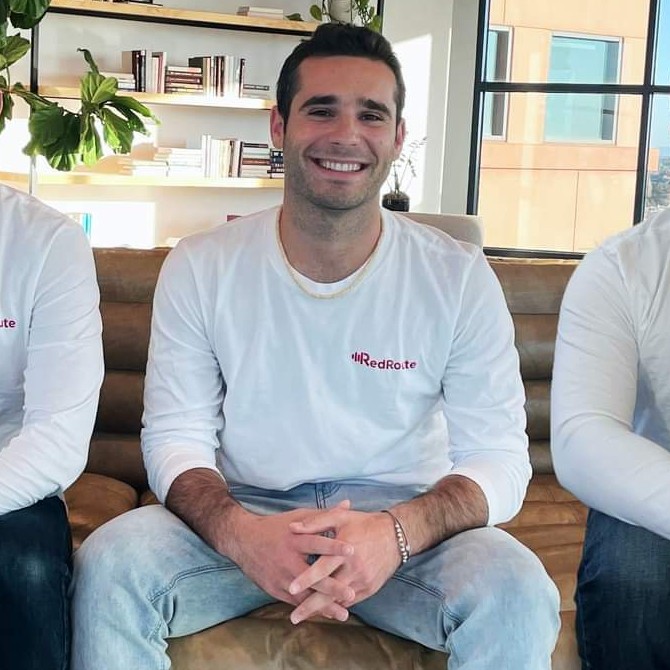
Brian Schiff
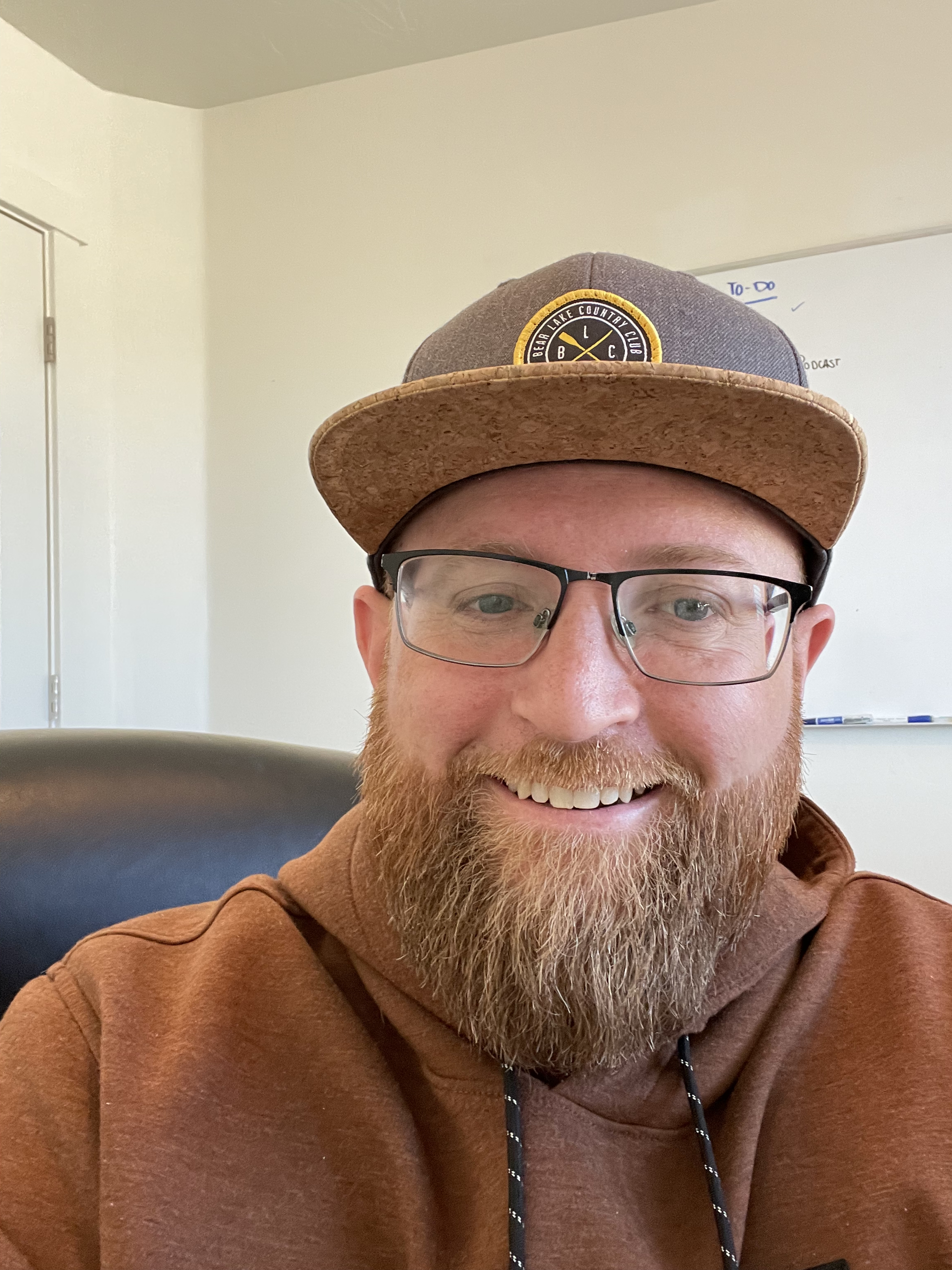
James Gilbert
Today's Guests

